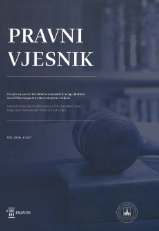MODELI REVIZIJE USTAVA
CONSTITUTION REVISION MODELS
Author(s): Jasmin HušićSubject(s): Constitutional Law, Government/Political systems
Published by: Pravni fakultet Sveučilišta Josipa Jurja Strossmayera u Osijeku
Keywords: constitution; revision; models of constitution change; inhibition mechanisms of the constitution revision;
Summary/Abstract: The paper deals with typing of the revision models of actual constitutions in the world, starting from the role and importance of the constitution’s revision subjects in the constitution’s revision process. Based on the established features of the constitutional rules on way and possibilities of revising the constitution, the author determines five basic revising constitution models: a) the parliamentary model, b) the referendum model, c) the parliamentary-referendum model, d) uni-personal model, and e) the combined or mixed model. Within the scope of these models, eight types and four sub-types of the revision of the constitution are differentiated. The parliamentary model is characterized by the decisive role of parliament with certain variations (five types) of this model. In the referendum model, the citizen’s expression is the primary characteristic. Constitutional changes cannot be made and no possibility of annulment of the results of the referendum can be determined without the consent of the citizens. The parliamentary-referendum is specific for approximately same importance of the decision of the parliament and the citizens, as none of these entities can independently decide on the changes. However, this model also has certain variations (types). The uni-personal model implies constitutional legal systems in which the changes of the constitution are decided by a uni-personal authority. The mixed model is particularly specific because of the possibility of making decisions by different bodies, independently. In addition, the paper provides an overview of the basic constitutional mechanisms of restricting and preventing the constitution change, such as a) the complexity of the procedure, b) the limitation of the initiation and submission of proposals, c) the quorum and the majority, d) the eternity clauses. In addition, the paper provides an overview of the basic constitutional mechanisms of restricting and preventing the constitution change, such as a) the complexity of the procedure, b) the limitation of the initiation and submission of proposals, c) the quorum and the majority, d) the eternity clauses.
- Issue Year: 36/2020
- Issue No: 1
- Page Range: 99-133
- Page Count: 35
- Language: Croatian

